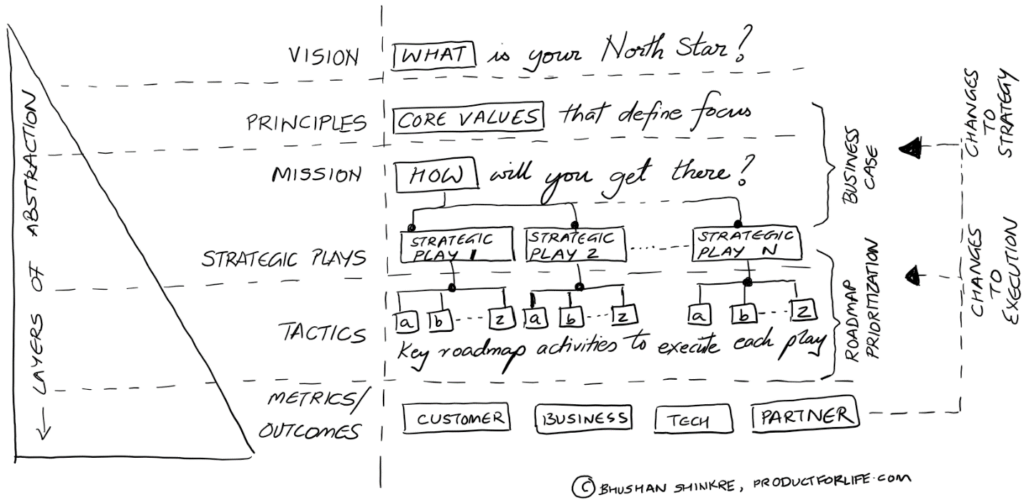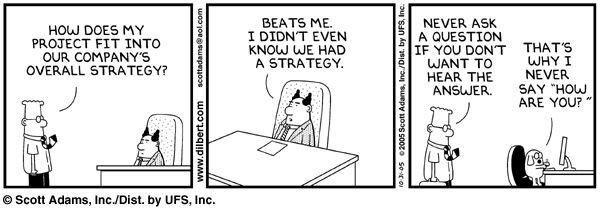You just landed a high-profile product role and your first set of executive orders is to build a product strategy. It’s a scary thought and you are probably mulling how and where to begin. You may start with your company’s vision and OKR; however, let’s be honest, most of them don’t directly translate into product strategy. Whether you need to craft a brand-new one or follow one, there are a few essential ingredients to a robust strategy that guides product success and the teams backing it.
Defined in “value pyramid” format, here’s a framework that I like to apply when freshly approaching product strategy. Let’s look at it top down.

VISION:
This is the “WHAT” part – What do you intend to achieve? A well-crafted vision is aspirational, it is meant to inspire your customers, colleagues, and partners. It is the bedrock of product strategy and should avoid tactical language at all costs. Vision is not meant to be altered, only a significant event such as a company pivot warrants a change. It can be visually inspiring such as Apple’s original Machintosh Ad or a dead simple one-liner such as Disney’s “To make people happy.” If you notice closely, companies with well-received vision statements have been tremendously successful and have always kept customers at the front and center.
PRINCIPLES:
Principles are your group’s or product’s core values that act as guidelines or guardrails to realize your vision. They could be cultural values that dictate customer focus or the ways in which you focus on your business. By far the greatest example of well-written principles that can be applied anywhere is Amazon’s leadership principles. You could have product principles that only focus on features that are differentiated, time-sensitive and of frequent use. Essentially, principles are the guided pathways that steer strategic thinking, facilitate critical decision making, drive execution and deliver results.
MISSION:
This is the “HOW” part – How do you plan to get there? While vision signifies the destination and principles act as guided signposts to get there, the mission sets the direction to achieve it. Consider the mission as your product’s GPS; a well-crafted mission outlines key steps to realize the vision. Like vision, it should be customer focused and should have undertones of your product’s value prop; in any case, it should offer absolute clarity on key plays to achieve that vision. A framework I typically like to utilize is:
Offer a <differentiator> <product> to <key persona(s)> by <strategic initiative 1>, <strategic initaitive 2> and <strategic initaitive 3>.
Successful companies and groups have absolute clarity on what they intend to achieve in their mission statement. Few good examples of mission statements are (note that I’ve italicized what I think are the company’s key strategic plays):
Honest Tea: To create and promote great-tasting, healthy, organic beverages.
Patagonia: Build the best product, cause no unnecessary harm, use business to inspire and implement solutions to the environmental crisis.
STRATEGIC INITIATIVES:
Each strategic initiative has clear customer benefit or value being created, business impact or value being extracted, and competitive differentiation in the market. You might have heard about this saying – Strategy without execution is hallucination – make sure that your strategic play is achievable and measurable. This is the time to fortify your strategy using qualitative analysis, backed by quantitative rigor. There are a variety of strategic planning frameworks such as Amazon’s PR-FAQ or Lean Canvas to design and structure your thinking – that’s a dedicated topic for another time. Here’s a few examples to give you a sense of it:
Lean Canvases of FAANG companies
Amazon AWS’s working backwards / PRFAQ
Prioritizing strategic initiatives is a form of art and science, thoughtful product leaders utilize holistic methods to run these exercises while staying flexible to changing customer or business needs. This is also the time to start planning key investments in technology or services to realize those initiatives.
TACTICAL PLAYS:
Venturing towards the execution side, each strategic play gets broken down into a set of measurable actionable steps. They could be expressed as a set of product capabilities, business requirements, use cases or bite-size user stories. This is the build step where you plan, groom, scope and execute the plays via agile ceremonies such as Scrum, Kanban or Extreme Programming. Your release schedule might
follow a structured or unstructured release cadence, depending on the app or platform you’re building. Whatever you are building and releasing, it is crucial to measure outcomes and own responsibility to communicate out to your customers, partners and colleagues. I’ll be writing a series of articles on tactical monitoring, outcome-driven metrics and rollout planning, so stay tuned for those.
A beautiful example of roadmap execution is utilizing SVPG’s Dual-Track Agile Methodology: TrustPilot platform’s review retention initiative.
METRICS:
Earlier I mentioned – strategy without execution is hallucination; this metaphor also applies to execution – Execution without measurement is delusion. Metrics need to be outcome driven in terms of customer or business impact, and not focused on your task completion or the fact that you built and launched something. It is also crucial that they are organizationally aligned and there is no confusion on their definition, measurement and outcomes. Any area that product touches should have some form of success metric – customer, business, services, technology, and so on. There are a few frameworks available out there such as SVPG’s Product Scorecard, Google’s HEART, SMART, etc. that can be utilized to define them and bring visibility across the organization. Look out for an article or talk on this crucial topic.
To conclude, this framework is not meant to be prescriptive but rather educational. Choice is yours on what you’d like to incorporate and how you’d like to structure your approach, be creative and put your own stamp. As an end note, I want to caveat that leaders often mix vision and mission terminologies. It’s okay to do so as long as there is clarity on “WHAT” you intend to achieve and “HOW” you will achieve it. Happy Strategizing!
